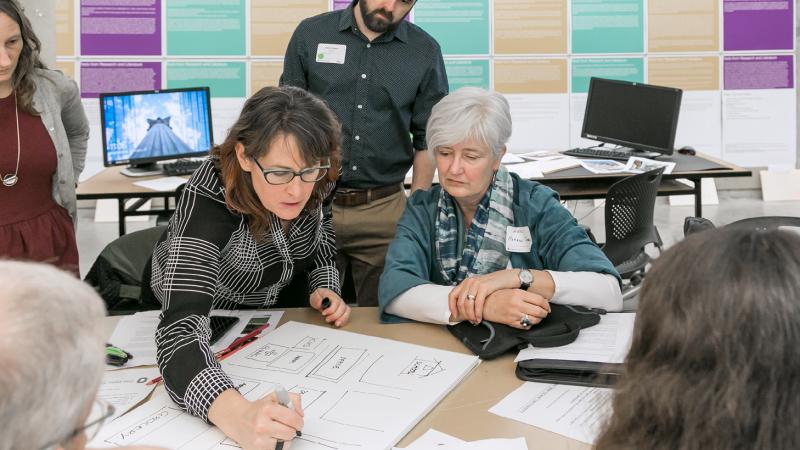Beyond “The Cliff”: Charrette Proposes Planning Solutions for the Autistic Community
It’s called “the cliff.” It refers to the time when people with autism age out of services offered to those 18 and younger through the Individuals with Disabilities Education Act. Between now and 2026, some 400,000 younger Americans with autism will cross into adulthood. City and Regional Planning Professor of Practice Kyle Ezell led two undergraduate studios and a graduate workshop that explored ways that planners, architects and landscape architects can create communities where adults with Autism Spectrum Disorder (ASD) can thrive beyond the cliff.
“People with autism have a lot of social anxiety. Dealing with issues in the world can be terrifying for them,” commented Dr. Emilio Amigo of Amigo Family Counseling, a clinical psychologist and research partner. “Adults with autism are overlooked in the planning process; they remain more socially isolated and generally lack confidence in navigating public transportation and securing housing. The absence of accommodations in their communities makes their journey out of their bubble even harder.”
Currently there are few resources available to planners to initiate and implement accommodations in the public realm for high-functioning adults on the autism spectrum. In addition to an extensive literature review, students conducted a 50-city phone survey to identify autism-specific policies, but found none. “While there is related research on physical disabilities, there is virtually no literature in the planning field on cognitive disabilities such as autism,” stated Ezell. “The work that follows will forge a new trail in the planning practice for this underserved group.”
In January, the studio formed two focus groups, one with young adults with ASD and the other, their parents. These interactions, jointly coordinated with Autism Living (AL), a local non-profit focused on how young adults, challenged by autism, can join intergenerational neighborhoods focused on mutual support, identified the challenges and obstacles faced by this community in utilizing amenities in the built environment. This information was then compiled by the planning students into 28 project proposals within the categories of housing, transportation and recreation.
In February, the students conducted a three-day charrette to expand these proposals into actionable interventions. A multidisciplinary collaboration of planners, architects, landscape architects, public health professionals, civil engineers, neuroscientists and local leaders launched the charrette, developing topics into policies and programs that can change how cities and communities better accommodate adults with ASD. “These ideas were then shared with members of the ASD community to garner their feedback to further hone these amenities for practicality and comfort,” research partner and city and regional planning PhD student Gala Korniyenko added.
“What I heard that I thought would be nice was converting garages into houses. I would enjoy living on my own,” stated an adult participant on the autistic spectrum who participated in the charrette. While many participants expressed a desire for increased independence, experts acknowledge that, for many, total self-sufficiency may not be possible. “The students developed a zoning code that encourages options such as accessory dwelling units (ADU) and duplexes,” commented Rick Stein (MCRP ’07), a representative from Autism Living. “Housing options like these can be coupled with concepts such as "intentional neighboring," to provide an environment where those with ASD have security and benefits from living within close proximity of a mentor and/or caregiver.”
Transportation was another category that elicited high interest. Most adults on the autism spectrum do not drive. Plans for bus stops, offering design elements that are identifiable, weather resistant and technologically capable, as well as bus routes that propose a circular model with shorter, looping lines for increased connectivity, were proposed. A connected wayfinding idea was an “I Need Assistance Symbol,” a universal icon that can alert people with ASD to places where they can seek assistance. “All of these accommodations are really about reducing anxiety, to give those with ASD a chance to be present; to participate and to take advantage of life’s opportunities,” commented Dr. Amigo.
“Many of the infrastructure project ideas are implementable with a few simple tweaks; for example, designing wider sidewalks to lessen crowding and over stimulation. Housing and transportation ideas are more complex, but possible over time,” commented Ezell. To facilitate these changes, students will compile their findings and research into a toolkit for planners that will include infrastructure designs, site plan designs and general development proposals within a model zoning code. “We discovered early on that planning and building communities through the lens of autism not only benefits people on the spectrum—the new designs can make places work better for everyone,” added Ezell.
Another outcome of the courses is the creation of an American Planning Association (APA) Interest Group, Planning with Underserved Populations. With increased engagement, the interest group can develop into an APA Division, bringing the needs of the ASD population into more formal discussions concerning resources and innovation within the built environment.
“Being a member of the Planning for Autism Studio has helped me realize how I would like to move forward in my planning career by showing me how passionate I am about human-centric planning/design,” reflected city and regional planning senior Alyssa Saltzman. “I learned how vital it is to get feedback from as many people as possible, especially those in underrepresented populations, and what is required to plan for physical as well as non-physical disabilities.”
Several participants in the adults with autism focus group also appeared in Alexandra Shiva's Peabody Award-winning documentary, How to Dance in Ohio, which follows Dr. Amigo’s clients as they plan to attend a formal dance in Columbus. The documentary is currently in development as a stage musical by 21-time Tony Award-winning director and producer Harold Prince.
American Planning Association’s Planning Advisory Memo: Autism Planning and Design Guidelines 1.0


